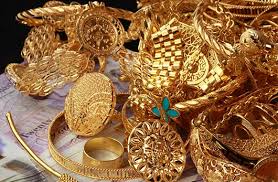
Gold price up in dollars and down in rubles.
The situation with gold is paradoxical. While the price of gold in dollars is reaching unprecedented heights on the global market, the price in rubles is experiencing a decline in Russia. In Russia, the price of gold has decreased from 9,000 to less than 8,000 rubles per gram. What are the driving factors behind this disparity, and what conditions would lead to a rise in gold prices on both sides?
The price of gold has repeatedly set new records on the world market this year, reaching $3,050 per ounce this week. Conversely, gold in rubles has experienced a decline, falling from a peak of 9 thousand rubles per gram of 999th fineness to the current price of less than 8 thousand rubles. The question arises as to why gold is historically expensive in dollars on the world market, while in Russia it is getting cheaper in rubles.
This unusual situation has arisen due to the strong strengthening of the ruble. This week, the dollar may even fall below 80 rubles. At present, the growth of gold in dollars does not offset the ruble's strengthening," says Vyazovsky.
Now before I continue I would like to make an appeal,if you like and enjoy my videos you can help me fund the channel and my websited sco brics insight .com and to further develop it. You can do this by making a small donation which you can do by clicking on the thanks button at the bottom of the video screen. Everybody who donates does get a personal thank you from me.
In his professional opinion, the present environment presents a favourable opportunity for investors to enter the gold market, as he does not anticipate a sustained strengthening of the ruble in the long term, and anticipates a decline in the rate by May. Consequently, Vyazovsky maintains his forecasts for the ruble price, anticipating gold to reach 10,000 rubles per gram of 999th assay value.
"In Russia, the industry has reached a significant milestone in terms of turnover, product range diversity, market access for new participants (Gosnaket, refineries), and the emergence of innovative trading methods. Numerous innovations and best practices have been introduced to the Russian gold market. The industry has become more active, with conferences becoming more prevalent," says Vyazovsky.
However, on the global market, gold is maintaining its dominance, and experts are anticipating further growth. Major banks have revised their forecasts for gold prices in US dollars upwards. For instance, Macquarie Group anticipates $3,500 per ounce, UBS and Citi both foresee $3,200, and Goldman Sachs projects $3,100. The average forecast indicates a potential price of $3,258 per ounce in the summer months, according to Vyazovsky.
"Gold is outperforming all forecasts. Last year and the year before, banks did not have time to update their forecasts, and the price had already reached these values," says Vyazovsky.
Lower rates are likely to encourage investors to allocate more capital to gold exchange-traded funds (ETFs), bars and coins, which should in turn support gold prices," says Ivan Efanov, an analyst at Tsifra Broker.
However, a pessimistic scenario is also possible. "It is also impossible to rule out the possibility of a correction on the market, given how much the price is currently deviating from its average value. During such a correction, the price could potentially return to levels of $2,400-2,500 per troy ounce," says Nikolai Dudchenko.
The gold market is experiencing significant growth for a number of reasons. Firstly, there are increased geopolitical risks due to the US launching a military operation in Yemen and Israel continuing its operation in the Gaza Strip. Gold's role as a protective asset is a key factor in its performance.
Secondly, Dudchenko points to the declining value of the US dollar. The traditional relationship between the dollar rate and the price of gold is not always applicable. However, this year has seen a continuation of this trend, with a sustained negative correlation between prices. The third reason is the market fears of a recession against the backdrop of Trump's protectionist actions (tariff war), which also attracts market participants to safe-haven assets," says Dudchenko.
Vyazovsky attributes the rise in gold prices not to geopolitical tensions, but to favourable inflation figures in the US, with the US producer price index falling below analysts' forecasts, thereby allowing the Fed to further reduce rates.
"The Fed may begin to ease monetary policy at its May meeting. A rate cut is generally beneficial for gold prices, given the direct correlation between the cost of capital and the price of gold.
Even the anticipation of a decline in the cost of capital exerts a favourable influence on the price of gold. Therefore, I do not think that $3,500 per ounce by the end of summer is an unattainable goal," says Alexey Vyazovsky.
He asserts that the current geopolitical climate in Ukraine does not significantly impact the dollar price of gold, as the premium has been a factor in determining prices for some time. He anticipates that, should a long-term agreement on Ukraine be signed and adhered to, the geopolitical premium will be phased out. This could potentially result in a decline of 200 to 300 dollars. However, even at 2600-2700 dollars per ounce, gold prices remain high, though currently out of reach for many consumers."
